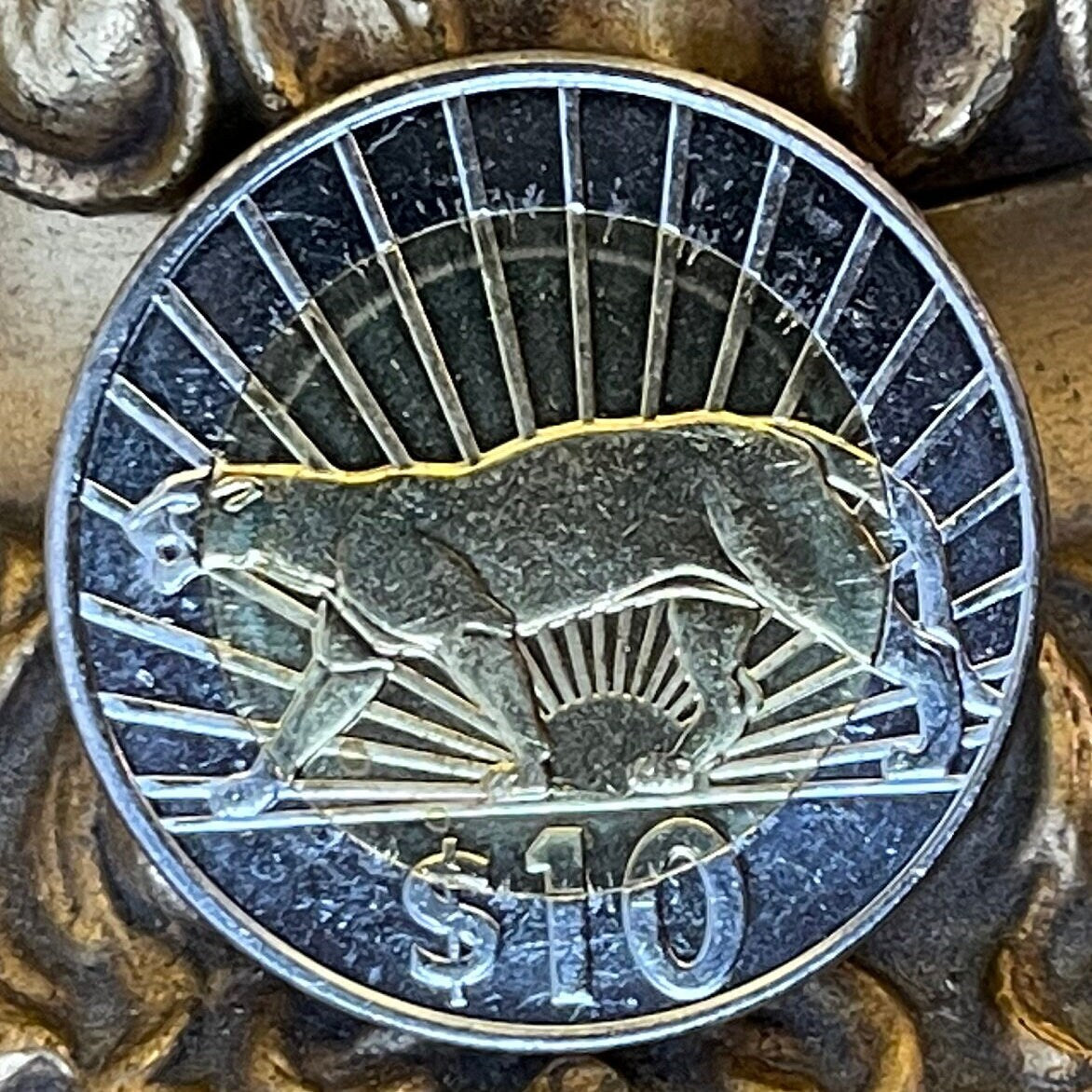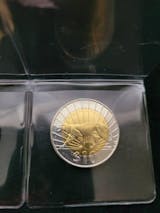elemintalshop
Cougar 10 Pesos Uruguay Authentic Coin Money for Jewelry and Craft Making (Puma) (Mountain Lion) (Panther) (Viracocha) (Bimetallic)
Cougar 10 Pesos Uruguay Authentic Coin Money for Jewelry and Craft Making (Puma) (Mountain Lion) (Panther) (Viracocha) (Bimetallic)
Couldn't load pickup availability
Cougar 10 Pesos Uruguay Authentic Coin Money for Jewelry and Craft Making (Puma) (Mountain Lion) (Panther) (Viracocha)
Commemorative issue: Cougar
Series: Native fauna of Uruguay
Obverse: Coat of arms surrounded by country name, year on bottom
Lettering: REPUBLICA ORIENTAL DEL URUGUAY
Translation: Eastern Republic of Uruguay (Uruguay)
Reverse: Cougar (Puma concolor) walking left in front of rising sun, with 19 rays, face value below.
Lettering: $10
Features
Issuer Uruguay
Period Oriental Republic of Uruguay (1825-date)
Type Circulating commemorative coin
Years 2011-2015
Value 10 Pesos Uruguayos
10 UYU = 0.23 USD
Currency Peso uruguayo (1993-date)
Composition Bimetallic: brass plated steel center in nickel plated steel ring
Weight 10.5 g
Diameter 28 mm
Thickness 2.3 mm
Shape Round
Orientation Medal alignment ↑↑
Number N# 22257
References KM# 134, Schön# 114
Wikipedia:
The cougar (Puma concolor) is a large cat of the subfamily Felinae. Native to the Americas, its range spans from the Canadian Yukon to the southern Andes in South America and is the most widespread of any large wild terrestrial mammal in the Western Hemisphere. It is an adaptable, generalist species, occurring in most American habitat types. Due to its wide range, it has many names, including puma, mountain lion, catamount, panther and painter.
The cougar is the second-largest cat in the New World after the jaguar (Panthera onca). Secretive and largely solitary by nature, the cougar is properly considered both nocturnal and crepuscular, although daytime sightings do occur. Despite its size, the cougar is more closely related to smaller felines, including the domestic cat (Felis catus) than to any species of the subfamily Pantherinae.
The cougar is an ambush predator that pursues a wide variety of prey. Primary food sources are ungulates, particularly deer. It also hunts insects and rodents. It prefers habitats with dense underbrush and rocky areas for stalking, but also lives in open areas. The cougar is territorial and lives at low population densities. Individual home ranges depend on terrain, vegetation and abundance of prey. While large, it is not always the apex predator in its range, yielding prey it has killed to jaguars, American black bears, grizzly bears, packs of wolves or coyotes, and (in Florida) to American alligators. It is reclusive and mostly avoids people. Fatal attacks on humans are rare, but increased in North America, as more people entered cougar habitat and built farms.
Intensive hunting following European colonization of the Americas and ongoing human development into cougar habitat has caused the cougar populations to drop in most parts of its historical range. In particular, the eastern cougar population is considered to have been mostly extirpated in eastern North America in the beginning of the 20th century, with the exception of the isolated Florida panther subpopulation.
In mythology
The grace and power of the cougar have been widely admired in the cultures of the indigenous peoples of the Americas. The Inca city of Cusco is reported to have been designed in the shape of a cougar, and the animal also gave its name to both Inca regions and people. The Moche people represented the cougar often in their ceramics. The sky and thunder god of the Inca, Viracocha, has been associated with the animal.
In North America, mythological descriptions of the cougar have appeared in the stories of the Hocąk language ("Ho-Chunk" or "Winnebago") of Wisconsin and Illinois and the Cheyenne, amongst others. To the Apache and Walapai of the Southwestern United States, the wail of the cougar was a harbinger of death. The Algonquins and Ojibwe believe that the cougar lived in the underworld and was wicked, whereas it was a sacred animal among the Cherokee.
********
Wikipedia:
The coat of arms of Uruguay or Uruguayan shield (Spanish: Escudo de Armas del Estado) was first adopted by law on March 19, 1829, and later on had some minor modification in 1906 and 1908. It was supposedly designed by Juan Manuel Besnes Irigoyen (1788–1865).
Description
It consists of an oval shield, which is divided into four equal sections and crowned by a rising golden sun, the “Sun of May”, symbolizing the rising of the Uruguayan nation and the May Revolution. The oval is surrounded by a laurel branch on the left and an olive one on the right, representing honor and peace, joined at the bottom by a light blue ribbon, the former Uruguayan cockade.
In the upper left quarter there is a golden scale on a blue background, symbol of equality and justice.
The upper right quarter contains the Cerro de Montevideo (Montevideo Hill) with its fortress on top on a silver background, as a symbol of strength.
In the lower left, also on a silver background, there is a galloping black horse, symbolizing liberty.
The lower right quarter holds a golden ox on blue background, as a symbol of abundance.
Share










Awesome addition to my collection!
Exactly as described. A perfect addition to my talisman collection.
Good quality! Each coin was in a separate protective case. Fast delivery. Good seller, thank you!
Just what I wanted at a great price. Thanks!
5 stars review from Manu










